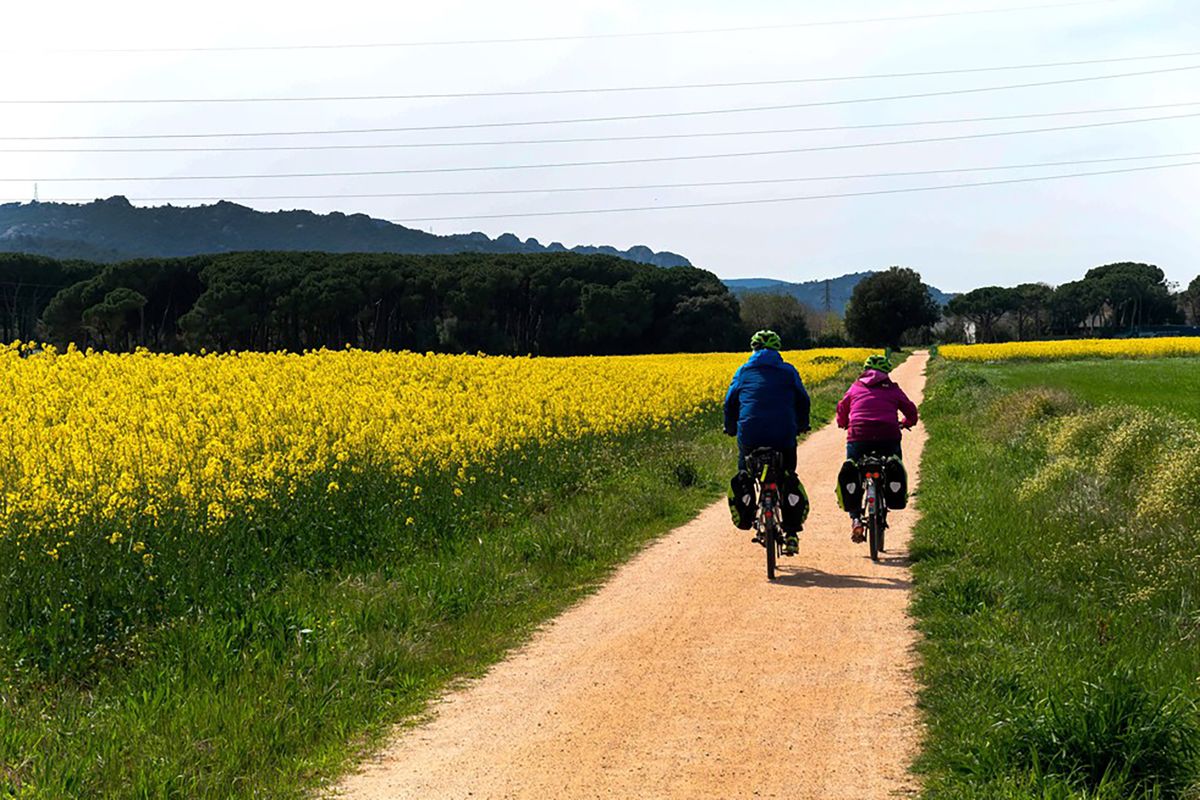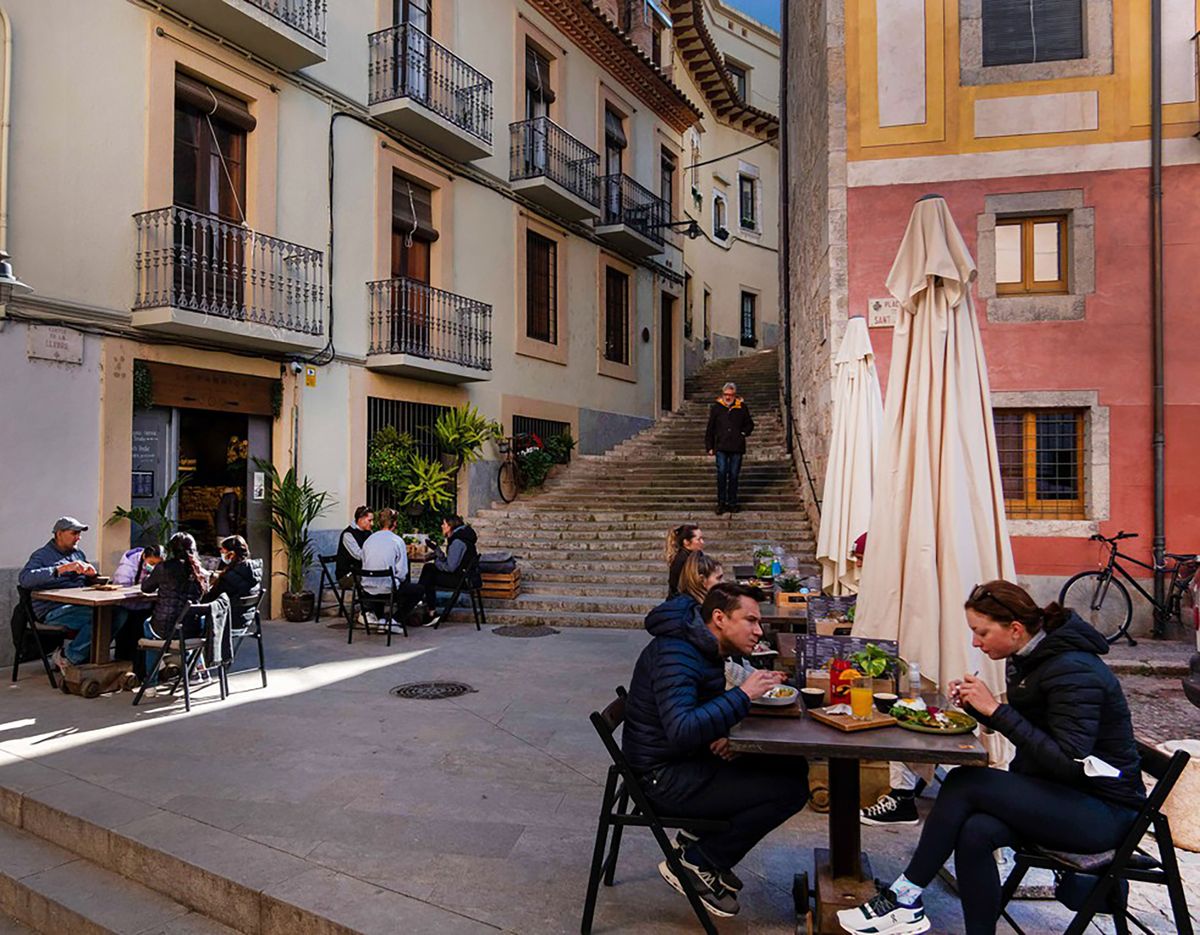Why cyclists are heading to Girona, Spain
Cyclists ride along a field of blooming canola, which, for about a month every spring, light up the Spanish landscape with their neon-yellow hue. (Dina Mishev/For the Washington Post)
I didn’t think physics and the laws of gravity allowed this, but it is possible to go 3 mph – slower than a motivated pedestrian – on a bicycle without falling over. Had someone told me this before I started riding up the nearby mountain, Rocacorba, a classic and amazingly steep road bike ride near the northern Spanish city of Girona, I would not have believed them. But, grinding my way up the mountain, both my Garmin GPS watch and cycling computer mounted on my rental bike’s handlebars – I’m so incredulous, I have to check both – agree that my riding speed is, in fact, apace with a sleepwalking snail.
My trajectory up the road, which ascends approximately 2,600 vertical feet over about seven miles, is far from straight. To keep myself from tipping over, I’m constantly adjusting my steering and body position, which results in a path that “wobbly” barely begins to describe. About four miles into the climb, shortly after the road goes from steep to stupidly steep, I think toppling over onto the pitted pavement might be less painful than grinding up it.
Even in the granniest of granny gears, it’s impossible for me to pedal smoothly up pitches with grades approaching, and sometimes exceeding, 13%. I feel sharp, stabby pains in both knees. Road rash seems preferable.
In early April, on the first day of a week-long cycling vacation, there is no particular reason beyond curiosity that I decide to ride from Girona to Rocacorba via Lake Banyoles, the cattail-ringed lake that was the site of the rowing events during the 1992 Barcelona Olympics.
I’m curious about Rocacorba, because it is easily seen from pretty much everywhere in Girona, a city with about 100,000 residents and near the Pyrenees and the Mediterranean Sea, with a medieval old town that was used as a filming location for HBO’s “Game of Thrones.” Also, I’m curious because Rocacorba is one of the Rihannas of road riding in Europe, a ride so famous among cyclists that it needs only a single name, such as Stelvio in northern Italy, Tourmalet and Ventoux in France, and Sa Calobra on the Spanish island of Mallorca.
Halfway up the climb, I decide that curiosity might kill me – or at least make my knees so sore they won’t want to ride the rest of the week. I turn around. After all, Girona today is recognized as one of Europe’s greatest cycling destinations and has a diversity of roads and rides. If I’m not enjoying grinding up a steep climb, there is no need to grind up a steep climb.
Christian Meier, a Canadian retired professional cyclist who raced the 2014 Tour de France on the Orica-GreenEdge team and who has lived in Girona since 2008, agrees. “One of the things Girona has going for it really is that you’ve got all kinds of rides,” he says over espresso at La Fabrica, a cafe in Girona’s old town that he and his wife, Amber, founded in 2015. “The high Pyrenees aren’t far away, the coast road is pretty spectacular, and you’ve got climbs from Rocacorba to Els Àngels, which is right behind the city and has a nice grade.” It brings me more than a little satisfaction to hear that Meier himself doesn’t enjoy the ride up Rocacorba. “It’s super steep and impossible to get into a rhythm, and the road surface isn’t in great shape. There are so many other, better climbs in the area,” he says.
Meier is part of the second generation of professionals to make Girona their home. Among the first English-speaking pros to move to Girona were George Hincapie (in 1997) and Lance Armstrong (in 2001), who decided they liked it more than Nice, France, their former base. In the following years, a handful of Armstrong’s and Hincapie’s teammates followed. Meier says Girona was still a “sleepy town” when he arrived, but that in the early 2010s, the city really caught on with pro riders. “At one point, there were more than 100 of us,” he says.
It’s been in the past five years that Girona has caught on as a cycling destination for nonprofessionals. “There might be prettier places to ride – like Tuscany or the Dolomites – but Girona is the perfect storm for a biking holiday,” Meier says. “You can choose how hard you want to make your riding, and you’re in an amazing, historic European city with art, culture and great restaurants, and there’s also hiking and trail running.”
And, not that I timed this, but for about one month in early spring, there are neon-yellow fields of blooming canola. On the ride to Lake Banyoles and Rocacorba, the skies are overcast, but I have to wear sunglasses, because the fields are so luminous.
Meier tells me I should definitely ride to the Mediterranean Sea, east of Girona. The 160 miles of Spanish coastline between the mouth of the River Tordera northeast of Barcelona, into the province of Girona and up to the French border, is called the Costa Brava. The morning after Rocacorba, though, I return to the shop I rented my road bike from, Cycle Tours Catalonia, and ask for GPS routes for rides that maximize canola viewing opportunities. I can’t imagine scenery – even the craggy Costa Brava – beating the blooming canola.
Canola fields are not the only criteria I give Carlos, the shop’s manager, though. I ask for rides between 40 and 65 miles and with climbs no steeper than 8% in grade.
“So, flat rides?” he asks. I say no before he finishes his question. I love descending. Tearing downhill on a bicycle at speeds between 30 and 60 mph – speeds that, yes, can be terrifying, and that took me a long time to be comfortable doing – is as close as I’ll ever get to flight. I’ll happily pedal uphill for several hours to enjoy this feeling, but not if it causes sharp pains in my knees. Also, steep roads are difficult to ascend, and descending them is often less satisfying than descending a moderately pitched road. Steeper roads usually require more braking, which means less feeling as if you’re flying.
Carlos has a library of more than 100 GPS tracks, and he quickly finds five that meet my criteria and gets them downloaded onto the Garmin bike computer I brought from home. (If you don’t have your own computer, the shop rents those, too.)
I start with a 62-mile loop ride that includes canola fields, a moderate climb about 1,500 feet up a mountain in the Catalan Coastal Range, a giggling-with-glee descent down to the Mediterranean and, on the way back to Girona, more canola fields. Along the way, there are also churches that date to the 17th century, forests of cork, oak and chestnut trees, and more cyclists – speaking German, French, Catalan, Spanish, Swedish and English with an Australian accent – than cars.
At the bottom of the descent from Sant Grau d’Ardenya, where GIP-6821 ends and I turn north on GI-682, nicknamed the “Road of 1,000 Bends,” I stop atop a snaggly cliff that crumbles down into the Mediterranean to take photos. I stop again at least every quarter-mile for the next 10 miles. The canola fields are not the best scenery the area has to offer.
At Sant Feliu de Guíxols, the northern terminus of the impossibly photogenic Road of 1,000 Bends, I am tempted to lunch at one of the many outdoor restaurants overlooking the town’s beach and harbor. But I have a reservation for a late-afternoon chocolate-themed brunch on the rooftop terrace of a hotel back in Girona, about 25 miles away. So instead, I snack on the xuixo, a regional pastry that is deep-fried, sugarcoated and stuffed with crema Catalana, that I bought that morning at the bakery down the street from my apartment and get back into the saddle.
Over the week, I do not do all five of the rides Carlos downloaded onto my Garmin. One on them – the “Hincapie Loop,” so named because it was a favorite of Hincapie’s – has two such perfectly pitched climbs (and descents), blindingly blooming canola fields, villages with cobblestone streets, and expansive vistas of the Pyrenees and the Mediterranean that I do it twice.
Another day, with Meier’s words that riding is only part of Girona’s appeal in my head, I leave my bike in my apartment. Instead, I hike about 90 minutes from Girona’s old town to the ruins of an ancient castle on the summit of a mountain in the nature preserve, Les Gavarres, southeast of the city. I also walk stone walls dating from the ninth century that have helped protect (or not) the city from invading Visigoths, Moors and French. At a gelateria offshoot of a nearby Michelin three-star restaurant, I try violet and coconut sorbet. Several hours later, because violet, a new flavor for me, turned out to be pretty tasty, I have the confidence to return to try another unusual ice cream flavor, Parmesan, which, it turns out, I prefer on pasta. An evening soak in thermal baths washes the last of the residual Rocacorba pain from my knees.
Information: spain.info/en




